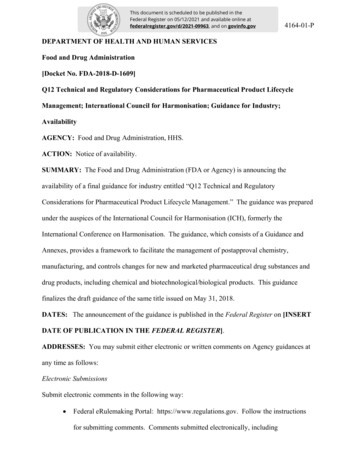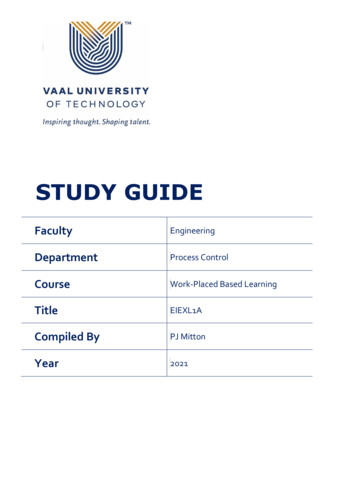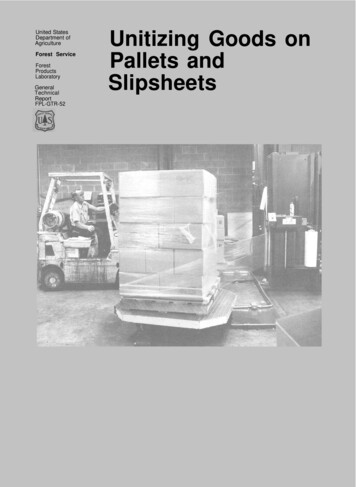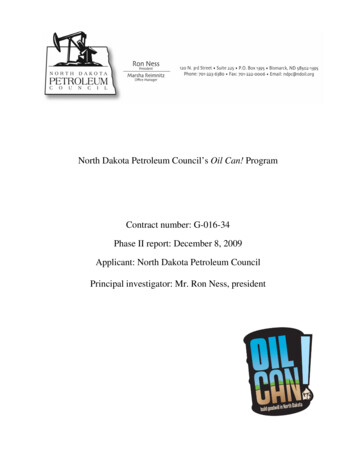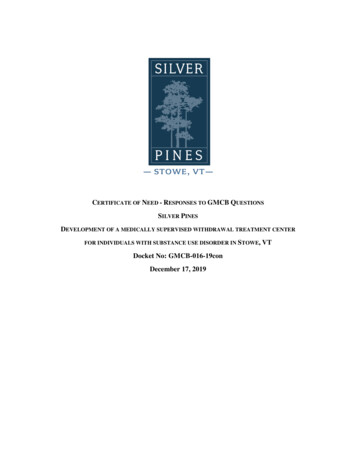
Transcription
CERTIFICATE OF NEED - RESPONSES TO GMCB QUESTIONSSILVER PINESDEVELOPMENT OF A MEDICALLY SUPERVISED WITHDRAWAL TREATMENT CENTERFOR INDIVIDUALS WITH SUBSTANCE USE DISORDER IN STOWE, VTDocket No: GMCB-016-19conDecember 17, 2019
TABLE OF CONTENTSUtilization and Staffing . 3Clinical Programming . 8Community/System of Care Integration . 20Financial . 25Other . 26Reimbursement . 29Appendix I – Articles from Peer-Reviewed Journals . 31Appendix II – Updated Financial Tables 3-Year Pro Forma . 38Appendix III – Updated Financial Tables 6A, 6B, and 6C . 43Appendix IV – Exhibit A: Draft Floor Plans . 51
CON Application – Additional Questions and ResponsesDocket No. GMCB-016-19conUtilization and Staffing1. The application states on page 12 that a number of Vermonters currently get treatmentout of state due to a preference for a customized approach with a high clinical providerto-patient ratio. Please provide data to support this statement.Specific quantitative information on the number of Vermonters who receive residential substanceuse disorders (SUDs) treatment out of state due to a preference for a customized approach with ahigh clinical provider-to-patient ratio is not publicly available. Our assertion was based on thepremise that a customized high staff-to-patient ratio treatment modality is desirable, and that nosuch services are currently available in Vermont. Thus, we posited that individuals who areseeking such a treatment approach for themselves or their loved ones would currently have toobtain these services out of state.2. The application states on page 24 that the number of Vermont residents seekingtreatment at Silver Pines will be limited because the facility will not be contracting withMedicaid or Medicare. In a table format, provide the total projected number ofindividuals to be admitted to Silver Pines in Years 1, 2 and 3 of operation; thenumber/percent that are expected to be Vermont residents; and the number/percentthat are expected to be out-of-state residents.Current residential treatment programs in Vermont often operate near capacity, so the actualnumbers seeking treatment at Silver Pines will depend both on excess demand that is currentlyunmet and on the number of individuals who choose treatment at Silver Pines in preference toanother facility.Though it is not possible to predict with certainty the number of Vermonters that will seektreatment at Silver Pines, we can make estimates based on the following information. Ourformula and conservative projections below take into account health insurance providers, levelsof care, and need in the State.The Treatment Episode Data Set (TEDS) maintained by the Substance Abuse and Mental HealthServices Administration (SAMHSA) shows that in 2017, the most recent year for which data areavailable, there were 9,634 admissions of individuals age 18 and over to substance use treatmentprograms in Vermont.1 The TEDS also includes nationwide information on payers, showing thatin 2017 a total of 14.8% of treatment episodes were paid for by private insurance or self-pay, theforms of reimbursement that will be accepted at Silver Pines. Through a personal communicationwith an outpatient SUDs treatment program in Vermont with a consecutive sample of 137patients, twenty-five of whom needed medically supervised withdrawal (MSW) or residentialtreatment, we estimated the percent of individuals in need of the level of care offered at SilverPines will be 18% of the total number receiving some level of SUD treatment.1Substance Abuse and Mental Health Services Administration (SAMHSA). 2019. Treatment Episodes Data Set(TEDS): 2017. SAMHSA: Rockville, MD.Page 3 of 54
CON Application – Additional Questions and ResponsesDocket No. GMCB-016-19conThe calculations are as follows:9,634 (number of people age 18 or older who were admitted to SUD treatment in VT in 2017)2multiplied by 14.8% (paid by private insurance or self-pay, from national data)3 1,426multiplied by 18% (people in need of MSW and/or residential treatment) 257Therefore, we expect 257 eligible/potential patients per year.We have conservatively estimated that only a minority of individuals will be from Vermontinitially due to the presence of larger and longer-established programs, but among treatmentseeking individuals who meet admission criteria, preference will be given to Vermont residents.We then assume that the number of potential patients that are Vermont residents that will chooseSilver Pines will increase over time as the reputation and visibility of Silver Pines grows. Weassume that in Year 1, 15% of the 257 eligible individuals will choose Silver Pines; 25% will doso in Year 2; and, 35% will do so in Year 3. Therefore, the expected number of patients are thefollowing: Percent who will choose Silver Pines in Year 1 is 15% 257*15% 39 Percent who will choose Silver Pines in Year 2 is 25% 257*25% 64 Percent who will choose Silver Pines in Year 3 is 35% 257*35% 90Year 1Year 2Year VermontResidents396490% of SPExpectedPatientOut-of-StatePopulation Residents10.7%3269.7%5969.8%831% of SPPatientPopulation89.3%90.3%90.2%3. The application states on pages 16 and 21 that the facility will have the highest staff-topatient ratio in the state. The application also states on page 5 that Silver Pinesproposes to offer one of the highest clinical staff-to-patient ratios in the country. Pleaseprovide support for these assertions and describe the projected clinical staff-to-patientratios at Silver Pines for Years 1, 2, and 3 of operation (which should correspond to thestaffing and utilization tables submitted as part of the application). Please also describehow these projected ratios compare to other comparable facilities and specify thefacility(s).Data on local and nationwide clinical staff-to-patient ratios at MSW and residential SUDsfacilities is not publicly available from peer-reviewed sources as programs do not customarilytrack or report this information.2Substance Abuse and Mental Health Services Administration (SAMHSA). 2019. Treatment Episodes Data Set(TEDS): 2017. SAMHSA: Rockville, MD.3Ibid.Page 4 of 54
CON Application – Additional Questions and ResponsesDocket No. GMCB-016-19conOur assertion that Silver Pines proposes to offer one of the highest clinical staff-to-patient ratiosin the country is based on our contacts with a number of in- and out-of-state MSW andresidential programs. As such, these ratios are estimates from admissions’ staff at the facilitieswe contacted, and it is worth noting that there was often no agreed-upon definition of whatconstitutes a “clinical” staff member during these conversations.Nevertheless, what we discovered from our research is the clinical staff-to-patient ratio thatSilver Pines is committed to providing to ensure excellent medical, clinical and psychiatric careis higher than other facilities in Vermont (where information was available) and often equal tothe other premier addiction treatment centers in the country.ProviderSilver Pines Year 1(6-14 census)Silver Pines Year 2(16-22 census)Silver Pines Year 3(24-28 census)Valley VistaSerenity HouseBrattleboro RetreatCaronHazelden Betty FordMountainsideSilver HillPine Tree Recovery CenterMcLean FernsideMcLean Borden CottageNew England Recovery CenterGreen Mountain Treatment CenterHanley CenterAscendant New YorkCliffside MalibuStateVermontClinical Staff-to-Patient Ratio2 to 1Vermont1.7 to 1Vermont1.3 to sNew HampshireFloridaNew YorkCalifornia1 to 3.71 to 3.4UnknownUnknownUnknown1 to 4Unknown1 to 21.5 to 11.5 to 11 to 4.21 to 2.51 to 12 to 12 to 14. Provide detailed information on how and where staff will be recruited.Our Human Resources Specialist will lead talent acquisition by utilizing many different avenuesto recruit Silver Pines’ staff. Recruitment will be primarily focused in Vermont, New Hampshire,and New York using various channels including, but not limited to, newspaper advertising invarious publications (e.g. Burlington Free Press, Seven Days, VT Digger, Barre MontpelierTimes Argus, Stowe Reporter, Valley News, etc.), online job search engines (Indeed.com,Monster.com, Ziprecruiter.com), local job fairs, open houses with on-the-spot interviews andPage 5 of 54
CON Application – Additional Questions and ResponsesDocket No. GMCB-016-19conword of mouth. In addition, if needed, we will contract with recruitment firms that specialize inhealth care staffing and offer sign-on bonuses and relocation fees for new employees.5. On page 2 of the Lease, please identify and describe the positions to be held by non-U.S.residents through the H2B program and J-1 Visa programs. Explain the potentialimpact on the project if these positions cannot be filled by non-resident workers.All employees will have either U.S. permanent residency (green cards) or U.S. citizenship. Wedo not anticipate needing to hire any non-U.S. residents.6. Specify the qualifications for the Aftercare Specialists and the Recovery Specialistspositions.Aftercare Specialists will have a minimum of an Associate’s Degree and 1-2 years’ experience inthe substance use treatment field. Their main job responsibilities will include: Coordinating the individual’s care with external providers and community resources,including family members, primary care providers (PCPs), psychiatrists, outpatientprograms, legal aids, family interventionists, university administrative staff, andemployee assistance program representatives. Reviewing individual’s discharge records from previous treatment providers andcontacting emergency contacts, family members, former providers, and referral sources. Collaborating with the individual and Silver Pines’ multi-disciplinary team to create,design, and schedule a comprehensive plan, which takes into account the housing andtherapeutic needs of the individual post-discharge to sustain recovery.Recovery Specialists will have a minimum of a high school diploma or GED, a minimum of 1years’ experience in the substance use treatment field, and be or be applying to be a VermontCertified Recovery Coach. Their main job responsibilities will include: Addressing the day-to-day non-therapeutic needs of individuals using a calm,professional, and friendly manner. Facilitating 12-step support, life skills, and wellness groups and coordinating relatedoutings. Modeling and encouraging pro-social behaviors such as peer support meeting etiquette,time management, appropriate language, and dress. Welcoming new admissions by ensuring that all individuals have welcome materials andtheir accommodations are clean and orderly. Performing baggage and property searches and checking in personal property Ensuring safety by monitoring individuals’ whereabouts and performing bed checks tomaintain an accurate patient census. Assisting with milieu activities and developing and maintaining professionalinterpersonal relationships with individuals to support their recovery. Transporting individuals for admission, discharge, external appointments, communitygroups, etc.Page 6 of 54
CON Application – Additional Questions and ResponsesDocket No. GMCB-016-19con7. Provide more detailed information about the “medically intensive treatment” to beprovided by the Medical Assistants and the qualifications required for this position.Medically intensive treatment will be provided by our entire multi-disciplinary team, includingphysicians, nurses, medical assistants, counselors, aftercare specialists and recovery specialists.Medical Assistants will be certified nursing assistants that have completed training to dispensemedications while working under the supervision of a Registered Nurse. Specifically, theMedical Assistants will be responsible for: Assisting nursing staff in performing initial history and physical exams. Monitoring, reporting, and documenting individuals’ blood pressure, pulse, respirations,temperature and symptoms of withdrawal. Monitoring, reporting, and documenting any change in individuals’ medical andpsychological status. Monitoring, reporting, and documenting all of the individuals’ activity and behavior. Maintaining alertness for signs and symptoms of emerging medical or psychiatriccomplications, and communicating these to a supervisor and other relevant members ofthe treatment team. Safely administering medications to individuals at the medication window or inindividuals’ rooms as needed. Assisting individuals with activities of daily living as appropriate. Attending to any day-to-day health situations that may arise among clients. Implementing appropriate MSW protocols and other policies and procedures. Performing laboratory specimen collections and drawing blood. Helping to identify short- and long-term individual care issues to be addressed duringtreatment at Silver Pines and after discharge. Facilitating health-related psychoeducation groups.Page 7 of 54
CON Application – Additional Questions and ResponsesDocket No. GMCB-016-19conClinical Programming8. Provide a detailed description of the medical, clinical and adjunct services to beintegrated into each episode of treatment. Beginning with programming for the firsthour of an individual’s day through the last hour, outline what a typical day intreatment will include, clearly identifying the number of hours of clinical services,medical services, and all other services to be provided on and off site each day.Time7:00amActivityWake-up/Morning MedicationStaff FacilitatorRecovery ery Specialist9:00amMorning Process Group/MindfulnessClinician10:00amEvidenced-Based Group TherapyClinician11:00amWellness (TaiChi/Qigong, Massage,ContractedMeditation, Acupuncture)LunchRecovery Specialist1:00pmIndividual or small group break-outClinician2:30pmRecovery Skills/Aftercare PlanningClinician/Aftercare Specialist3:30pmPsychoeducationClinician4:30pmFree TimeRecovery Specialist5:00pmDinnerRecovery Specialist6:00pmSupport and Recovery meetingRecovery Specialist12:00pmAA/NA, Smart Recovery, etc.7:00pmAssignment TimeRecovery Specialist8:00pmOpen Gym/Free TimeRecovery Specialist9:00pmEvening Process Group/MedicationRecovery overy Specialist/Nurse*Note: weekends will incorporate family programming and visitations.**Admissions and discharges occur throughout the day.Total clinical programming hours per day: 6.Page 8 of 54
CON Application – Additional Questions and ResponsesDocket No. GMCB-016-19con9. The application states on page 6 that whereas the current paradigm in additiontreatment leads to variable results and frequent relapses, the model that will be offeredat Silver Pines will lead to better outcomes in terms of increased abstinence anddecreased relapse rates, which will in turn yield cost savings for the healthcare systemthrough, for example, potentially fewer emergency department visits. Please providesupport for the assertion that the model of care offered at Silver Pines leads to betteroutcomes in terms of increased abstinence and decreased relapse rates.High rates of relapse after acute treatment have long been recognized for a variety of substancesranging from alcohol to opioids to nicotine.4 5 Addictions are now widely recognized as chronic,relapsing-remitting conditions for which longitudinal treatment is important, and in the case ofopioid use in particular, ongoing pharmacotherapy is a key component of effective treatment.6Emphasis at Silver Pines will therefore be placed on engaging individuals in planning forongoing treatment, including psychosocial modalities and, in the case of opioid use disorder(OUD), maintenance pharmacotherapy with either buprenorphine/naloxone or naltrexone.Pharmacotherapies such as naltrexone or acamprosate will also be encouraged for patients withalcohol use disorder based on their demonstrated efficacy for promoting abstinence anddecreasing heavy drinking.7In all cases, Silver Pines’ staff will work to locate treatment resources in individuals’ homeareas, customize treatment plans to match the available options (e.g. the choice betweenbuprenorphine and naltrexone for OUD may be influenced by availability of waiveredprescribers for the former), and make arrangements for ongoing medical and psychosocialtreatments during admission to Silver Pines. For those beginning pharmacotherapy, this willinclude an initial appointment with a prescriber able to continue the chosen medication(s) afterdischarge. Staff at Silver Pines will also work to connect individuals with ongoing psychosocialtreatment, which has been shown particularly important for promoting abstinence fromsubstances for which effective pharmacotherapies are lacking, such as cocaine andmethamphetamine.8Available evidence strongly supports such a longitudinally oriented approach. In the case ofOUD, numerous studies have demonstrated increased retention in treatment and decreased ratesof relapse with ongoing treatment that includes pharmacotherapy, as well as reductions in4Hunt WA et al. 1971. Relapse rates in addiction programs. Journal of Clinical Psychology 27:455-456.Weiss RD et al. 2011. Adjunctive counseling during brief and extended buprenorphine-naloxone treatment forprescription opioid dependence. Archives of General Psychiatry 68:1238-1246.6Fiellin DA et al. 2014. Primary care-based buprenorphine taper vs maintenance therapy for prescription opioiddependence: a randomized clinical trial. JAMA Internal Medicine 174:1947-1954.7Kranzier HR, Soyka M. 2018. Diagnosis and pharmacotherapy of alcohol use disorder: a review. JAMA 320:815824.8Dutra L et al. 2008. A meta-analytic review of psychosocial interventions for substance use disorders. AmericanJournal of Psychiatry 165:179-187.5Page 9 of 54
CON Application – Additional Questions and ResponsesDocket No. GMCB-016-19conoverdose and all-cause mortality.9 10 11 Economic studies have also demonstrated decreased totalmedical costs for patients with OUD engaged in ongoing pharmacotherapy.12 13For patients with OUD planning to begin naltrexone, the requirement for a week of initialabstinence from all opioids poses a substantial challenge, with rates of dropout from treatmentduring this time in outpatient settings approaching 25% in clinical trials.14 The treatmentapproach at Silver Pines will allow intensive monitoring, support, and symptomatic treatment ofopioid withdrawal during this period to improve on the outcomes demonstrated in outpatientpractice. While controlled trials of inpatient versus outpatient initiation of naltrexone have yet tobe conducted, pharmacotherapy of withdrawal symptoms has demonstrated efficacy indecreasing symptoms15 and concurrent engagement in evidence-based psychosocial therapies hasbeen demonstrated to enhance retention,16 and Silver Pines will utilize both strategies to helpindividuals initiating naltrexone remain in treatment throughout the initiation process. Protocolsat Silver Pines will also be continually updated as new evidence and practices emerge, such asmore rapid procedures for initiating naltrexone, which are promising but still investigational atpresent.17Treatment at Silver Pines will also include comprehensive psychiatric assessment by trainedmental health clinicians and psychiatrists, and initiation of behavioral and pharmacologictreatments where indicated. Nationwide surveys show that nearly half of individuals with SUDsalso have one or more co-occurring psychiatric disorders, such as major depression orgeneralized anxiety,18 and clinical trials demonstrate that effective treatment of these conditionscan promote recovery and increase rates of abstinence.199Sordo L et al. 2017. Mortality risk during and after opioid substitution treatment: systematic review and metaanalysis of cohort studies. BMJ 357:1550.10Evans E et al. 2015. Mortality among individuals accessing pharmacological treatment for opioid dependence inCalifornia, 2006-10. Addiction 110:996-1005.11Mattick RP et al. 2014. Buprenorphine maintenance versus placebo or methadone maintenance for opioiddependence. Cochrane Database Syst Rev CD002207.12Mohlman MK et al. 2016. Impact of medication-assisted treatment for opioid addiction on Medicaid expendituresand health services utilization rates in Vermont. Journal of Substance Abuse Treatment 67:9-1413Baser O et al. 2011. Cost and utilization outcomes of opioid-dependence treatments. American J Managed Care17s8:s235-s248.14Lee JD et al. 2017. Comparative effectiveness of extended-release naltrexone versus buprenorphine-naloxone foropioid relapse prevention (X:BOT): a multicentre, open-label, randomised controlled trial. Lancet 391:301-318.15Gowing L et al. 2016. Alpha2-adrenergic agonists for the management of opioid withdrawal. Cochrane Databaseof Systematic Reviews CO002024.16Amato L et al. 2011. Psychosocial and pharmacological treatments versus pharmacological treatments for opioiddetoxification. Cochrane Database of Systematic Reviews CD005031.17Gowing L et al. 2017. Opioid antagonists with minimal sedation for opioid withdrawal. Cochrane Database ofSystematic Reviews CD002021.18Substance Use and Mental Health Services Administration (SAMHSA). 2018, Key Substance Use and MentalHealth Indicators in the United States: Results from the 2017 National Survey on Drug Use and Health. HHSPublication No. SMA 18-5068.19Nunes EV, Levin FR. 2004. Treatment of depression in patients with alcohol or other drug dependence: a metaanalysis. JAMA 291:1887-1896.Page 10 of 54
CON Application – Additional Questions and ResponsesDocket No. GMCB-016-19con10. Detail the withdrawal management protocols for each substance addressed at SilverPines.Management of Opioid Withdrawal Protocol20 21 22 23 24 25General considerations1. Non-opioid and agonist/partial agonist strategies both have support for decreasingwithdrawal symptoms.2. Agonist/partial agonist treatment has evidence of greater symptom relief and retention, butnon-opioids may be preferred when transitioning to antagonist treatment.3. Current recommendations call for 7 days without opioids before starting naltrexone; brieferprotocols have been studied but are not yet generally recommended.4. Buprenorphine and methadone both have strong supporting evidence, with buprenorphinepotentially safer on pharmacologic grounds and more available legally.5. Optimal taper duration is not clearly established, and relapse rates are high regardless ofduration without ongoing pharmacotherapy.6. Supervised withdrawal is not recommended unless the patient plans to start antagonisttreatment or declines ongoing pharmacotherapy (after discussion of risks).Suggested protocol (partial agonist)1. Score Clinical Opiate Withdrawal Scale (COWS) and check vitals every 4 hours2. If score is 8 or more:a. Give buprenorphine/naloxone (bup/nx) 4 mg sublingual (SL)b. Repeat every 2 hours until score 83. Score COWS every 4 hours for remainder of day 1a. Give bup/nx 4 mg SL if 8 or moreb. Maximum total 12 mg for the day4. Score COWS on day 2:a. Give total from day 1 if score 8b. Give day 1 total 4 mg if score is 8 or more5. Score COWS every 4 hours for remainder of day 2a. Give bup/nx 4 mg SL if score is 8 or moreb. Maximum total 16 mg for the day20American Society of Addiction Medicine (ASAM). 2015. The ASAM National Practice Guideline for the Use ofMedication in the Treatment of Addiction Involving Opioid Use. American Society of Addiction Medicine: ChevyChase, MD.21Gowing et al. 2017a. Buprenorphine for managing opioid withdrawal. Cochrane Database of Systematic ReviewsCD002025.22Gowing et al. 2017b. Opioid antagonists with minimal sedation for opioid withdrawal. Cochrane Database ofSystematic Reviews CD002021.23Gowing et al. 2014. Alpha2-adrenergic agonists for the management of opioid withdrawal. Cochrane Database ofSystematic Reviews CD002024.24Sevarino. 2019. Medically supervised opioid withdrawal during treatment for addiction. UpToDate 31.0, Topic7808.25Substance Abuse and Mental Health Services Agency (SAMHSA). 2018. Medications for Opioid Use Disorder:TIP Series 63. HHS Publication No. (SMA) 18- 5063. Substance Abuse and Mental Health Services Administration.Page 11 of 54
CON Application – Additional Questions and ResponsesDocket No. GMCB-016-19con6. Taper over the next 7 days, based on day 2 totala. 16 mg: 12 – 8 – 8 – 4 – 4 – 2 – 2b. 12 mg: 8 – 8 – 4 – 4 – 2 – 2 – 0c. 8 mg: 4 – 4 – 4 – 2 – 2 – 2 – 0d. 4 mg: 4 – 2 – 2 – 2 – 2 – 0 – 07. Supplement as needed with symptomatic adjuncts (per non-opioid protocol)Suggested protocol (non-opioid)1. Clonidine 0.1-0.3 mg PO q 6 hours PRN COWS 4a. 5 or more: 0.1 mgb. 13 or more: 0.2 mgc. 25 or more: 0.3 mgd. Hold for SBP 902. Hydroxyzine 50 mg PO q 6 hours PRN anxiety or insomnia3. Ibuprofen 400 mg PO q 6 hours PRN musculoskeletal pain4. Loperamide 4 mg PO, then 2 mg per loose stool (maximum 16 mg/day)5. Ondansetron 4 mg SL q 6 hours PRN nausea or vomitingManagement of Alcohol Withdrawal Protocol26 27 28 29 30 31 32 33 34General Considerations1. Benzodiazepines are the best-supported agents for relieving symptoms and preventingcomplications.2. Adjuncts and alternatives have limited evidence, mainly when response to IVbenzodiazepines is inadequate; none are suggested in the protocol below since transfer toacute medical care would be appropriate before reaching this point.3. Symptom-triggered approaches have solid evidence of producing similar outcomes with lessmedication and briefer treatment.4. Evidence on choice of benzodiazepine is mostly lacking; diazepam, chlordiazepoxide, andlorazepam are evidence-supported and commonly used and recommended.26Amato et al. 2010. Benzodiazepines for alcohol withdrawal. Cochrane Database of Systematic ReviewsCD005063.27Caputo et al. 2019. Diagnosis and treatment of acute alcohol intoxication and alcohol withdrawal syndrome:position paper of the Italian Society on Alcohol. Internal and Emergency Medicine 14:143-160.28Eyer et al. 2011. Risk assessment of moderate to severe alcohol withdrawal—predictors for seizures and deliriumtremens in the course of withdrawal. Alcohol and Alcoholism 46:427-433.29Gortney et al. 2016. Alcohol withdrawal syndrome in medical patients. Cleveland Clinic Journal of Medicine83:67-79.30Long et al. 2017. The emergency medicine management of severe alcohol withdrawal. American Journal ofEmergency Medicine 35:1005-1011.31Maldonado et al. 2015. Prospective validation study of the prediction of alcohol withdrawal severity scale(PAWSS) in medically ill inpatients: a new scale for the prediction of complicated alcohol withdrawal syndrome.Alcohol and Alcoholism 50:509-518.32Mayo-Smith et al. 1997. Pharmacological management of alcohol withdrawal: a meta-analysis and evidencebased practice guideline. JAMA 278:144-151.33Wood et al. 2018. Will this hospitalized patient develop severe alcohol withdrawal syndrome? JAMA 320:825833.34Schuckit MA. 2014. Recognition and management of withdrawal delirium (delirium tremens). NEJM. 371:21092113.Page 12 of 54
CON Application – Additional Questions and ResponsesDocket No. GMCB-016-19con5. Most guidelines suggest longer-acting benzodiazepines as first choice for potentially moresustained relief of symptoms.6. Diazepam has the most rapid onset, which has been suggested to decrease the likelihood ofunnecessary repeat administrations.7. Lorazepam or oxazepam are generally suggested for patients with impaired liver functioningto avoid prolonged sedation.8. Prediction of complications (i.e. seizures or delirium tremens) is very limited, with validatedtools like the Prediction of Alcohol Withdrawal Severity Scale (PAWSS) mainly predictingwho develop any withdrawal requiring treatment.9. Utility of routine oral thiamine is unclear, but patients with alcohol use disorder (AUD) are atincreased risk of deficiency and complications, and the costs and risks of supplementing are low.10. No benefit has been shown for magnesium supplementation.Suggested Protocol:1. Score Clinical Institute Withdrawal Assessment for Alcohol Scale (CIWA-Ar) andcheck vital signs every 4 hours2. If score is 8 or greater:a. Give diazepam 10 mg PO (20 mg if score is 15 or more)b. Repeat hourly until score 83. Continue until score 8 for 24 hours4. Give thiamine 100 mg PO daily for 5 daysTransfer to acute medical facility for any of:CIWA-Ar score 35Temperature 39 CConfusion, ataxia, or ophthalmoplegia (visibly dysconjugate or c/o blurring/doubling)3 consecutive vital signs with SBP 180 or DBP 1203 consecutive CIWA-Ar scores 20Hourly monitoring required for 8 hoursFor patients over 65 or with cirrhosis, use lorazepam 2/4 mg instead of diazepam.Management of Benzodiazepine Withdrawal ProtocolGeneral ConsiderationsBest practices for management of benzodiazepine withdrawal are less well researched, butguidelines call for a more gradual process, such as decre
CON Application - Additional Questions and Responses Docket No. GMCB-016-19con Page 4 of 54 The calculations are as follows: 9,634 (number of people age 18 or older who were admitted to SUD treatment in VT in 2017)2 multiplied by 14.8% (paid by private insurance or self-pay, from national data)3 1,426 multiplied by 18% (people in need of MSW and/or residential treatment) 257



